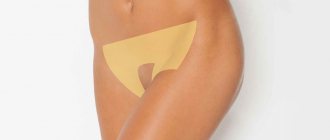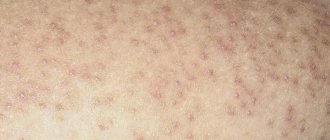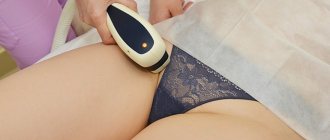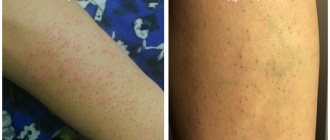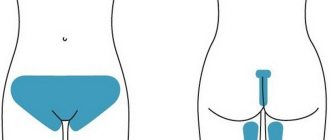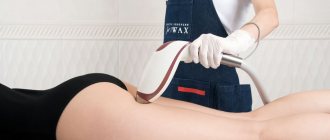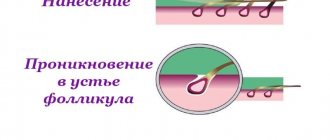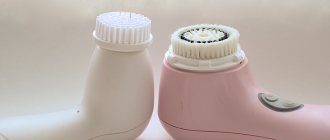Waxing
Gives a fairly long lasting effect.
If done correctly, you will be free from unwanted hair for at least a month. Cold wax is sold on paper or cellophane strips, which are heated to body temperature and applied to the skin. Pros:
A relatively inexpensive method that is easy to learn.
Minuses:
painful sensations - the strip of wax must be sharply torn off in the direction opposite to hair growth. And you will have to practice to understand how to do temporary hair removal with hot wax without damaging the skin.
Sugaring
This procedure is similar to waxing. Only sugar paste for sugaring is applied against hair growth, and torn off in the direction of growth, so the procedure is less painful.
Pros:
a paste made from natural ingredients does not heat up to temperatures that can cause burns and rarely causes skin irritation.
Minuses:
Sugar paste is not easy to apply. I'll have to practice.
Epilator
An electric cosmetic device in which, due to rapid rotation, a large number of tweezers work simultaneously.
Pros:
no special products or sticky substances.
Minuses:
Most people are only suitable for temporary hair removal on the legs and arms. Removing hair on the face, armpits or bikini area with it is painful. There is a risk of injury, scratches and pinched skin in sensitive areas.
What types of hair removal are used today?
All hair removal methods existing today are based on one principle - destruction of the hair follicle and overgrowth of the hair tubule. Moreover, hair removal has a significant difference in this from depilation, in which the hair is removed, but the bulb itself is not destroyed. Although many consider these processes to be approximately the same, but in vain.
The technology you choose to combat unwanted hair primarily depends on your goals: to remove hair only temporarily or to get rid of it forever. In the first case, methods such as:
- Shaving is an old and proven method, after which stubble appears on the second day.
- Plucking with an epilator or thread is an unpleasant and painful manipulation.
- Chemical methods (depilatory cream). Causes many allergic reactions.
- Bioepilation (waxing, sugaring, enzymatic). A good method, but after incorrect manipulation, hairs often grow under the skin.
For complete hair removal, one cannot do without hardware cosmetology methods, in which the destruction of the hair follicle occurs under the influence of various types of energy. These include:
- Laser hair removal, in which the hair growth area is exposed to laser radiation.
- Photoepilation - the growth zone is irradiated with thermal energy converted from light energy.
- Electrolysis - hair follicles are destroyed due to electrical energy converted into heat.
- ELOS hair removal – combines all types of energy – light, laser, electrical.
- Qool hair removal differs from conventional laser hair removal by the selective action of the laser only on the hairs themselves, leaving the skin intact.
- AFT hair removal, which involves selective exposure of hair follicles to pulsed infrared radiation.
Removing unwanted hair using sugaring
Sugaring has many similarities with waxing. From the name of the procedure it is clear that this method is carried out using sugar mass or gel to get rid of excess hair. The process itself is similar to waxing: the hair is completely removed, including the hair follicle.
Let's consider the sugaring procedure step by step, and also find out the reason for the high popularity of this method among most girls.
Removing unwanted vegetation using sugar originated long ago in the Middle East. It is based on the use of natural sugar mass, which also contains water and lemon juice. It is possible to add honey, aromatic oils and even salt to the composition.
Thanks to this product, unwanted hairs are removed along with the bulb. The effect will be long-lasting, for some girls it reaches six weeks.
On the Internet you can find various options for sugar paste from a variety of ingredients. But the original recipe contained only natural ingredients. Sugaring is often called sugar wax, because the mass is very similar to it.
Depending on the type of her skin, a woman can use both paste and gel. The advantage of sugaring is its simplicity; it can be done at home.
What features do the paste and gel have? What are the differences between the funds?
There are two types of sugaring: using paste or gel. Professionals call removing excess vegetation using sugar mass traditional. The heated composition is applied in a thick layer, always against the growth of unwanted hairs, using a spatula designed for this purpose. Next, the frozen mass is sharply torn off in the direction of growth.
The use of the gel is similar to wax depilation. It is applied in the direction of growth of unwanted hairs and removed in the opposite direction using a piece of fabric, a muslin strip.
You can master the art of sugaring yourself, or you can visit a salon where a master will conduct a depilation session for you.
As a means of removing unwanted hair, this method can slow down its growth and reduce the activity of new ones, and the shaft of growing specimens will be noticeably thinner and lighter.
Previously, finding a specialist who performed the sugaring procedure at a high level using paste was quite problematic. Today in various beauty salons you can attend such sessions without fear.
Read material on the topic: Laser hair removal of armpits: answers to the 8 most popular questions about the procedure
Pros and cons of different types of hair removal
To make it easier to choose the optimal type of hair removal or depilation for yourself, you need to take a closer look at their pros and cons. It is clear that all types of hair removal have a huge advantage in that in just a few procedures you can get rid of signs of excess hair for a long time or even forever.
Depilation methods cannot boast of this property, but they do not cause any harm to health. It is not for nothing that all methods are dubbed with one general term “bioepilation”. So, below are the pros and cons of each method, which you can learn more about by following the links provided.
Shaving
- the simplest of all procedures
- short-term effect of smooth skin, frequent irritation and ingrown hairs
Plucking with a depilator or thread
- an inexpensive procedure that partially destroys the structure of the hair follicle
- soreness, frequent skin irritation and risk of wound infection
Chemical method
- can be done independently at home, painlessness and speed of treatment of the problem area
- the effect lasts for just a few days
Waxing
- speed of procedure and reduction of excess hair as sessions are repeated
- pain, short-term effect
Sugaring
- low cost and speed of implementation
- short-term effect
Enzyme hair removal
- hair is removed for a long time
- a course of several sessions, the use of chemical structures (chymotrypsin, trypsin) that can cause allergies, and the presence of contraindications
Laser hair removal
- non-invasiveness and low pain upon exposure, as well as the ability to get rid of vegetation for a long time (from 2 to 5 years)
- the course of procedures is affordable, and the intervals between them are 2-3 months. The method has a number of absolute contraindications and is ineffective for blond and gray hair
Photoepilation
- high efficiency immediately after the first session, safety and slight discomfort during the procedure, getting rid of vegetation for several years
- high cost, the need for a course of several procedures, a number of contraindications, as well as a ban on the use of alcohol-containing cosmetics after manipulation
Electrolysis
- more affordable cost compared to photo and laser hair removal, as well as the ability to remove hairs permanently, regardless of skin phototype and hair structure
- duration of the procedure and pain at the site (local anesthesia may be required)
Video: about types of hair removal: laser, electrolysis and photoepilation
ELOS hair removal
- painless, no possibility of skin damage, permanent removal of all types of hair
- high cost of sessions, for full effect you need to take a course
Qool hair removal
- painless and safe method, hair leaves the skin forever
- high cost, wide range of contraindications
AFT hair removal
- painless, safe, effective on all hair types and hair removal forever
- high price
Where did it come from
The fashion for removing unwanted hair originated in Mesopotamia . There, vegetation was removed using sharp shells and stone scrapers. Later, using resin, herbs and donkey fat, they learned to create something like a depilatory cream.
In Egypt, smooth skin was achieved using resin and wax. In addition, the Egyptians used honey paste.
In Ancient Greece, the presence of hair on the body indicated a low class person, so vegetation was removed from the entire body except the head. The Greeks got rid of hair using fire, tweezers and tincture of bryonia, and the Romans used twisted thread to pluck hairs.
Beauties of the Middle East also performed hair removal with threads and used sugar paste, which is considered to be the ancestor of sugaring.
The devegetation craze began in the 20th century . Then women began to remove hair in the armpit due to the fact that dresses with short sleeves came into fashion. But this was also facilitated by a shortage of nylon, which is why women were forced to get rid of their hair using a safety razor. After this, the fair sex painted their legs to match the color of their stockings and drew a stocking line.
Since the 60s of the twentieth century, due to the trend towards increasing exposure of the body, new methods of depilation began to appear, which continue to be improved to this day.
What type of hair removal should I choose?
How to find out which type of hair removal is better, and which one will be optimal for you? To do this, you need to follow several rules:
- In any case, first consult a specialist who will assess your health, hair and skin type. Some types of hair removal may not be effective for your hair type.
- Identify contraindications that are often found when describing procedures; do you have them? Often their presence in the patient reduces the possibility of choosing one or another method.
- It should be taken into account that some types of hair removal cannot be performed if the patient has metal prostheses or electronic devices in the body. In addition, you need to consider whether you are allergic to certain drugs and cosmetics.
If you go through selection “from the opposite”, that is, first eliminate all methods that cannot be carried out (due to certain contraindications), then among the remaining ones it will not be difficult to choose the optimal method of hair removal. In this matter, you will also need the help of a cosmetologist.
Video: Types of hair removal and their comparison
Ultrasonic method
Almost every women's forum discusses ultrasonic hair removal methods. The system is exactly the same as the laser one, the root of the hair is simply destroyed using sound waves. Differences between ultrasound and laser techniques :
- The sound affects all hair, any color, type and length;
- It's cheaper;
- There are no side effects: burns, inflammation, etc.
Photo – Ultrasonic hair removal
Which method is most effective?
A cosmetologist can determine which type of hair removal is most effective. The result of any method depends on the selection of the necessary parameters for performing the procedure and on the experience of the specialist. It is important not to violate the regime and intervals between procedures, especially hardware ones.
Let us remind you that the goal of each type of hair removal is to destroy the hair follicle, and this is not always possible in one session. Not all hair that a person has can be removed permanently. 30% of all hair follicles are in reserve and can grow even after a full course, so be patient and achieve perfect skin! All the time and effort (and even money) spent can pay off handsomely with persistence and patience.
Depilation with thread
The method of hair removal with thread was invented in Asia several hundred years ago, but it has only begun to gain popularity here in the last couple of years. Mainly used for facial depilation. Its main advantage is the almost painless removal of hair from follicles, as well as a long-lasting effect of skin smoothness. The thread is used to create a special loop that grabs and pulls out the hair. Correct maneuvers make this method painless, but it requires a lot of practice. The disadvantages of this procedure include its duration and the need to have special, difficult skills. There are many training videos on the Internet on how to remove hair with a thread, but we would still advise you to go to a beauty salon for this, where a professional will quickly and confidently rid you of unwanted hair.
Necessary body products before and after the procedure
To ensure perfectly smooth skin after depilation and prevent irritation, it is important to pay attention to skin care before and after the procedure.
The following products may be useful to prepare your skin for work:
- Natural scrub – to prepare the skin for depilation, it is used a day before;
- Chlorhexidine disinfectant solution;
- Talc or baby powder (if using phytoresin);
- Shaving foam or gel.
Also, after completing the work, it is important to provide the treated area with proper care using the following compounds:
- Chlorhexidine;
- Soothing lotion after depilation;
- Cream against ingrown hairs;
- Bepanten or Panthenol (for skin damage).
Also, after depilation, you should avoid visiting the bathhouse, sauna or swimming pool for a day.
